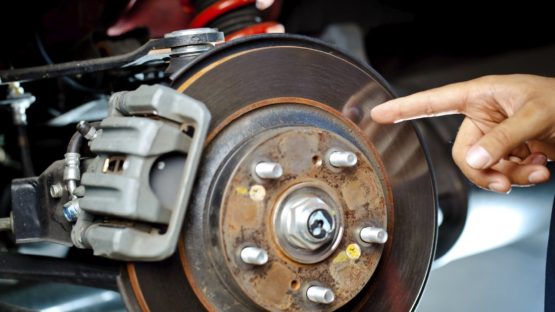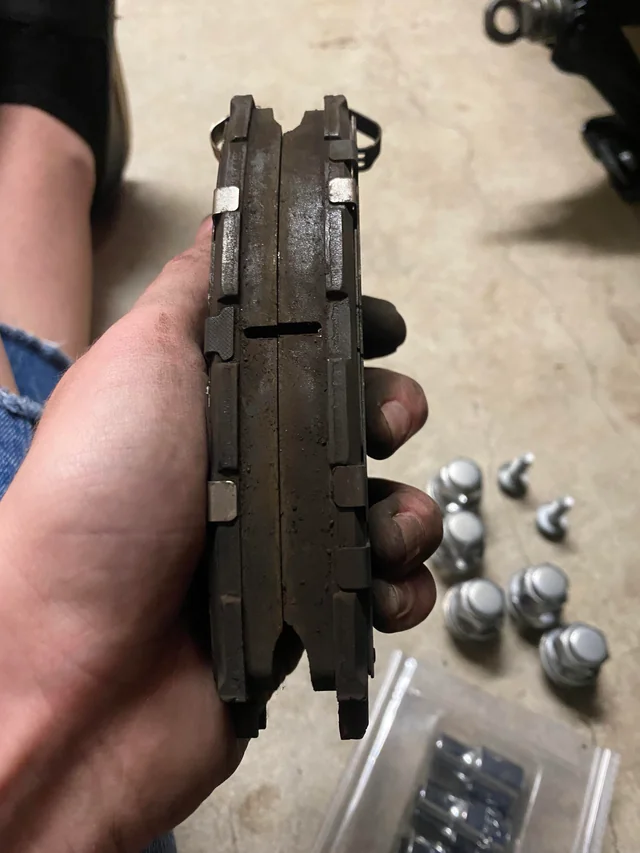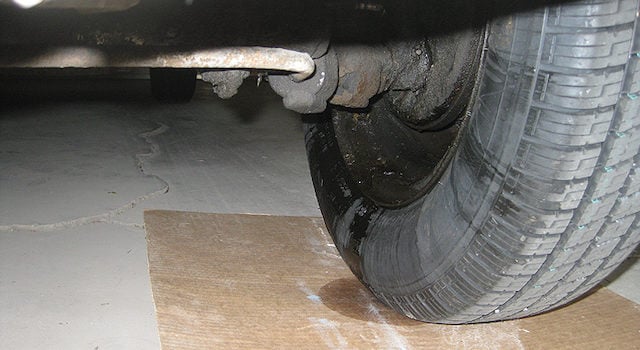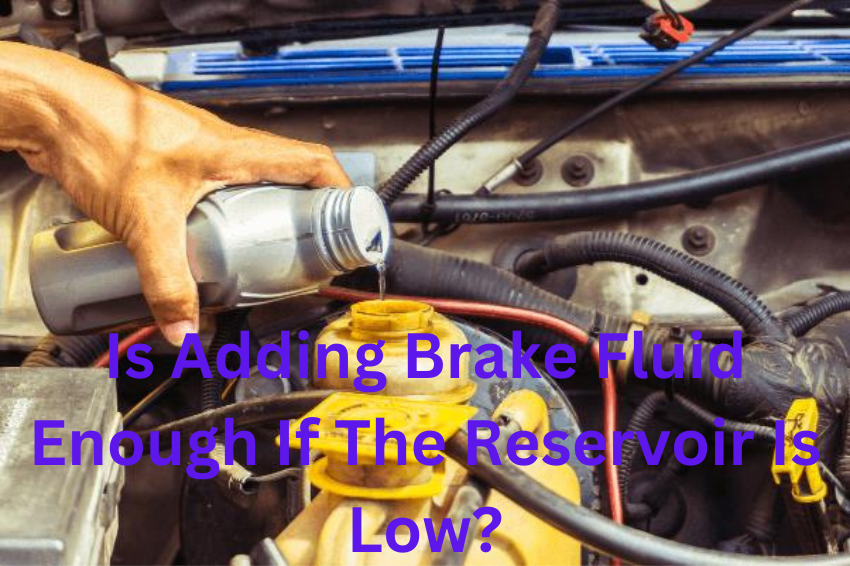Have you noticed your brake pedal feeling a bit spongy?
A low brake fluid reservoir can be a scary situation, raising concerns about your car’s safety.
ReviveNride team is committed to keeping you informed.
Regularly checking your brake fluid level is an important part of routine maintenance.
This guide will explain the risks of low brake fluid, what could be causing it, and how to proceed safely.
What Happens If I Drive With Low Brake Fluid?
Let’s understand what happens when you drive with low brake fluid:
Complete Brake Failure

This is the most severe danger.
If the brake fluid level gets critically low, air can enter the brake system.
Air is compressible, unlike fluid, which means your brakes won’t be able to build up the pressure needed to stop the car.
In this scenario, pressing the brake pedal might not slow you down at all.
Spongy Brake Pedal

This is a common warning sign of low brake fluid.
The pedal will feel soft and mushy when pressed, requiring more force to get any braking response.
This makes it difficult to modulate your braking smoothly and come to a controlled stop, especially in an emergency.
Increased Stopping Distance

Even a slight decrease in brake fluid can significantly extend how long it takes your car to come to a complete stop, especially at high speeds.
This can be dangerous in emergencies where you need to react quickly and stop on a dime.
Imagine needing to stop suddenly on the highway, but your car takes much longer than usual, that extra distance could mean a collision.
Ineffective Brakes

With low fluid, your brakes simply won’t work as well as they should.
You might experience a feeling that the car isn’t slowing down as effectively as usual, requiring you to pump the brakes repeatedly to maintain any stopping power.
This is because the system isn’t able to generate the necessary force to press the brake pads firmly against the rotors.
Please, don’t ignore the warning signs of low brake fluid.
If you notice a spongy pedal, increased stopping distance, or a brake warning light come on, pull over to a safe location as soon as possible and have your car checked by a qualified mechanic.
Driving with low brake fluid is simply not worth the risk.
Why Is My Brake Fluid Low?
There are two main reasons why your brake fluid level may be lower than usual.
It’s important to understand these causes so you can take the appropriate action.
Normal Brake Pad Wear

This is the most common reason for a slight decrease in brake fluid level.
As you drive, your brake pads wear down bit by bit.
To compensate for this wear and maintain proper contact between the pads and rotors, the piston in the brake caliper extends further.
This movement requires more brake fluid in the system, which can cause the level of the reservoir to go down.
While a small decrease is normal with use, a significant drop could indicate other issues.
Brake Fluid Leak

A leak in the brake system is a more serious concern and requires immediate attention.
Brake fluid is a hydraulic fluid, meaning it transmits pressure throughout the system to activate the brakes.
Leaks can occur anywhere in the system, including the brake lines, hoses, calipers, or the master cylinder.
A leak will cause the brake fluid level to drop continuously, and you might notice puddles of fluid under your car.
Here are some warning signs of a brake fluid leak, in addition to a low reservoir level:
- Spongy brake pedal: This indicates a lack of pressure in the system, often caused by air entering due to a leak.
- Uneven braking: The car might pull to one side when braking if there’s a leak in that specific brake line.
- Brake warning light: Most modern cars have a brake warning light that illuminates if there’s a problem with the brake system, including low fluid level.
If you notice any of these signs, don’t hesitate to take your car to a mechanic for a professional diagnosis and repair.
Remember, your brakes are essential for safe driving, so it’s important to address any issues promptly.
Can I Add Brake Fluid Myself?
Yes, you can add brake fluid to the reservoir.
Most cars have a designated brake fluid reservoir under the hood, typically marked with a brake fluid symbol.
You can usually purchase the correct brake fluid type from an auto parts store.
Here are safety considerations when adding brake fluid yourself:
- Using the wrong type of brake fluid can be dangerous. Different vehicles require specific brake fluid types (e.g., DOT 3, DOT 4). Using incompatible fluid can damage your brake system. Always consult your car’s owner’s manual to determine the correct type for your vehicle.
- Adding fluid might not address the underlying issue. A low brake fluid level can be a symptom of a more serious problem, such as worn brake pads or a leak in the system. Simply topping off the fluid won’t fix the root cause and could mask a potential safety hazard.
- Introducing air bubbles into the system can be dangerous. The brake system relies on a hydraulic pressure transfer for proper operation. Air bubbles in the lines can significantly reduce braking performance, increasing stopping distances and compromising safety.
Benefits Of A Professional Inspection:
- A qualified mechanic can diagnose the cause of the low brake fluid. They can perform a thorough inspection to identify any leaks, worn parts, or other issues affecting the system.
- Professionals ensure proper bleeding of the brake lines. This process removes any air bubbles that might have entered the system during fluid top-off, guaranteeing optimal braking performance.
- Mechanics can recommend necessary repairs or replacements. Based on their diagnosis, they can advise on fixing leaks, replacing worn brake pads, or performing other maintenance to ensure your brakes function safely and effectively.
Don’t hesitate to prioritize a professional inspection if you notice any issues with your brake fluid level or braking performance.
While adding fluid yourself might seem like a quick solution, a professional’s expertise can ensure your safety on the road.
How Much Brake Fluid Should I Add?
You might be wondering how much brake fluid to add if you notice your reservoir is low.
However, the priority here is safety, and adding brake fluid yourself can be risky.
The correct amount can vary greatly depending on your car.
Unlike engine oil, which often has a universal fill range, brake fluid systems have specific capacities.
Adding too much fluid can overflow the reservoir, causing damage to the brake system and potentially leading to poor braking performance.
Overfilling the reservoir can lead to brake failure.
Brake fluid expands slightly when it heats up.
If the reservoir is overfilled, this expansion can force fluid out through a vent, leading to a loss of pressure in the system.
This can result in a spongy brake pedal or even complete brake failure, which is extremely dangerous.
Adding fluid might not solve the underlying problem.
A low brake fluid level is often a symptom of a more serious issue, such as worn brake pads or a leak in the system.
Simply topping off the fluid won’t fix the root cause and could mask a potential safety hazard.
Here’s what we recommend:
Don’t focus on how much brake fluid to add yourself.
Instead, prioritize getting a professional inspection from a qualified mechanic.
They can diagnose the cause of the low fluid level and determine the safest course of action.
You can check your brake fluid level yourself for informational purposes.
Consult your car’s owner’s manual for instructions on how to locate and check the reservoir.
There will typically be MIN and MAX markings on the side.
However, this is only for checking the level, not for topping off the fluid.
Schedule a professional inspection for proper diagnosis and repair.
A mechanic can identify any leaks, worn parts, or other issues affecting the system.
They can also safely add the correct type and amount of brake fluid, ensuring your brakes function optimally.
Pro Tip: For safety reasons, it’s best to leave adding brake fluid to a qualified mechanic.
Reference Sources:
National Highway Traffic Safety Administration
